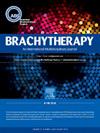Escalating the dose of high-dose-rate brachytherapy combined with external beam radiotherapy improves the disease control rate in patients with high- or very-high-risk prostate cancer
IF 1.7
4区 医学
Q4 ONCOLOGY
引用次数: 0
Abstract
PURPOSE
High-dose-rate brachytherapy (HDR-BT) combined with external beam radiotherapy (EBRT) is an effective treatment for patients with high- and very-high-risk prostate cancer. We sought to identify the factors associated with reduced biochemical recurrence rates following HDR-BT.
METHODS
A total of 304 patients with high- or very-high-risk prostate cancer who underwent HDR-BT and EBRT were analyzed. EBRT comprised 50 Gy in 25 fractions and HDR-BT comprised 18 Gy in 2 fractions. Biochemical recurrence was defined as an increase in prostate specific antigen (PSA) by ≥2.0 ng/mL from the nadir level.
RESULTS
The median follow-up time was 8.2 years (range, 3.4‒13.7 years) after HDR-BT. The 5-year biochemical progression-free survival (bPFS), overall survival, and cause-specific survival rates were 87.4%, 93.3%, and 100%, respectively. In univariate and multivariable analyses, a biologically effective dose (α/β = 1.5) ≥ 240 Gy and androgen deprivation therapy (ADT) were significantly associated with better bPFS (p = 0.020 and 0.007, respectively), whereas pretreatment PSA ≥ 40 ng/mL and Gleason score group 5 were significantly associated with worse bPFS (p = 0.080 and 0.021, respectively). Grade ≥ 3 rectal toxicities occurred in 0.3% of patients and grade ≥ 3 urinary toxicities occurred in 3.4% of patients.
CONCLUSION
In patients with high- and very-high-risk prostate cancer treated with EBRT and HDR-BT, dose escalation and ADT were associated with improved tumor control. By comparison, Gleason score group 5 and pretreatment PSA >40 ng/mL were associated with worse tumor control.
提高高剂量率近距离放疗联合外束放疗的剂量可提高高或极高危前列腺癌患者的疾病控制率。
目的:高剂量率近距离放疗(HDR-BT)联合外束放疗(EBRT)是治疗高、高危前列腺癌的有效方法。我们试图确定与HDR-BT后降低生化复发率相关的因素。方法:对304例接受HDR-BT和EBRT治疗的高、高危前列腺癌患者进行分析。EBRT为50 Gy,分为25组,HDR-BT为18 Gy,分为2组。生化复发定义为前列腺特异性抗原(PSA)较最低水平升高≥2.0 ng/mL。结果:HDR-BT后中位随访时间为8.2年(3.4-13.7年)。5年无生化进展生存率(bPFS)、总生存率和病因特异性生存率分别为87.4%、93.3%和100%。在单因素和多变量分析中,生物有效剂量(α/β = 1.5)≥240 Gy和雄激素剥夺治疗(ADT)与较好的bPFS显著相关(p = 0.020和0.007),而预处理PSA≥40 ng/mL和Gleason评分5组与较差的bPFS显著相关(p = 0.080和0.021)。0.3%的患者发生≥3级直肠毒性,3.4%的患者发生≥3级泌尿毒性。结论:在接受EBRT和HDR-BT治疗的高、高危前列腺癌患者中,剂量递增和ADT与肿瘤控制改善相关。相比之下,Gleason评分5组和预处理PSA >40 ng/mL与肿瘤控制较差相关。
本文章由计算机程序翻译,如有差异,请以英文原文为准。
求助全文
约1分钟内获得全文
求助全文
来源期刊

Brachytherapy
医学-核医学
CiteScore
3.40
自引率
21.10%
发文量
119
审稿时长
9.1 weeks
期刊介绍:
Brachytherapy is an international and multidisciplinary journal that publishes original peer-reviewed articles and selected reviews on the techniques and clinical applications of interstitial and intracavitary radiation in the management of cancers. Laboratory and experimental research relevant to clinical practice is also included. Related disciplines include medical physics, medical oncology, and radiation oncology and radiology. Brachytherapy publishes technical advances, original articles, reviews, and point/counterpoint on controversial issues. Original articles that address any aspect of brachytherapy are invited. Letters to the Editor-in-Chief are encouraged.
 求助内容:
求助内容: 应助结果提醒方式:
应助结果提醒方式:


